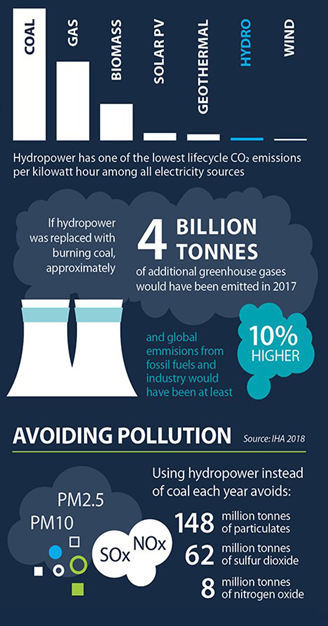Address
FPCCI Capital House, 5th Floor,
G-8/1, Mauve Area,
Islamabad - Pakistan (44000)
Hydropower – Facts and Figures
Hydropower is a renewable & clean source of energy that offers several advantages compared to its thermal based alternatives as well as competing sustainable generation technologies:
- Zero emissions: Unlike fossil fuels, hydropower does not release any harmful greenhouse gas or pollutants into the environment. Additionally, by replacing thermal plants, hydropower can significantly reduce net emissions and help mitigate climate change.
- Cost-effective: Hydropower is one of the most economical sources of energy. Low operating and maintenance costs coupled with a virtually zero fuel cost result in the generation of low cost electricity over the plants life cycle.
- Energy Security: The components of a hydroelectric power plant including the turbine, generator and the concrete dam are so resilient in construction that with proper maintenance, plants can last for many decades if not more, generating cheap power for over a century in some cases.
- Reduced dependence on fossil fuels: By relying on hydropower, countries can reduce their dependence on fossil fuels, which are finite resources that contribute to climate change and geopolitical conflicts. Hydropower can help diversify the energy mix and provide a reliable, sustainable source of energy for future generations.
- Reduced air pollution: Unlike fossil fuel power plants, hydropower does not emit harmful pollutants such as sulfur dioxide, nitrogen oxides, or particulate matter into the air. This can help improve air quality and reduce the health impacts associated with air pollution.
- Improved water quality: Hydropower dams can help regulate the flow of rivers and prevent floods, which can help prevent soil erosion and improve water quality. By creating reservoirs, hydropower plants can also improve water storage and distribution, which can benefit agricultural and industrial activities.
- Biodiversity conservation: Hydropower dams can create new habitats for fish and other aquatic organisms to promote biodiversity conservation. Additionally, hydropower plants can incorporate fish ladders, bypasses which allow fish to swim around the dam and reach upstream spawning grounds thereby helping maintain fish populations, which are important for maintaining the biodiversity of aquatic ecosystems.
- Sediment management: Hydropower dams can trap sediment behind the dam, which can reduce the amount of sediment that flows downstream and affects the downstream aquatic habitat. Sediment management can be done in a way that balances the need for hydropower generation with the need to maintain downstream ecosystems.
- Protection of downstream habitats: Hydropower dams can be designed to release water at specific times to maintain and control downstream river habitats. This can help preserve the natural water flow of rivers and streams, which is important for maintaining the habitat of aquatic species.
Auxiliary benefits: Hydropower plants can also provide additional benefits such as flood control, irrigation, and water supply for domestic, agricultural, and industrial use. These benefits can help support economic development and improve the quality of life for local communities.
